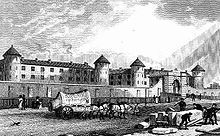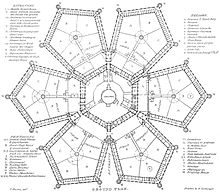George Peter Holford
George Peter Holford(1767–1839) was an English barrister, politician and author. With a short break 1806–7, he was a Tory Member of Parliament from 1803 to 1826, for a number of constituencies. Holford was an advocate ofprison reform.[1][2]
Early life[edit]
He was the second son ofPeter Holford,aMaster in Chancery,and his wife Anne Nutt, daughter of William Nutt ofBuxted.He was educated atHarrow School.[1]He matriculated atSt John's College, Cambridgein 1784, graduating B.A. in 1788, and M.A. in 1791.[2]
Holford enteredLincoln's Innin 1788 and wascalled to the barin 1791.[2]
In politics[edit]
Holford was a friend ofLord Castlereagh,who in 1802 becamePresident of the Board of Control,overseeing the East India Company. He was also on good terms with the rising Tory politiciansLord Hawkesbury,Richard RyderandNicholas Vansittart.At the end of 1802, the Prime MinisterHenry Addingtontold Holford that he would shortly be brought into theHouse of Commons.It was managed in January 1803, atBossiney,with the agreement ofLord Mount Edgecumbe.[1]When Addington made way forWilliam Pitt the youngerin May 1804,Benjamin Hobhousewho wasSecretary of the Board of Controlresigned, and Holford replaced him, working under Castlereagh to whom he became close.[1][3]
In 1806 Holford dropped out of parliament, no longer having support from Lord Mount Edgecumbe. But he was brought back in 1807, backed by the same interest atLostwithiel,as a prospective supporter of what became thesecond Portland ministry,and at Castlereagh's request.[4]He returned to the position as Secretary of the Board of Control, which he held then to 1809, leaving, as he explained to the PresidentLord Harrowbyin the aftermath of the duel between Castlereagh andGeorge Canning,out of sympathy with Castlereagh.[1]
Holford was a supporter of thePhilanthropic Society,and had been involved in 1806 in having it incorporated. He was invited in 1810 by Richard Ryder, theHome Secretary,to chair a select committee to implement thePenitentiary for Convicts Act 1794.A site atMillbankhad been found throughJames Cecil, 1st Marquess of Salisbury.[1][5]In 1812 Holford obtained a grant to proceed with a penitentiary for London and Middlesex convicted prisoners who had been sentenced totransportation.[1]For a few years from 1810, also, the Holford Committee allied itself with the generally Whig agitation set off bySamuel Romilly's campaign for criminal law reform, withHenry Grey Bennetand others, that made some piecemeal legislative progress.[6]In 1811–2 Holford was corresponding withJeremy Benthamon behalf of the committee, to obtain documentation of thePanopticonproject.[7]
In the end, Holford and the committee rejected Bentham's principles, and theNational Penitentiarywas constructed over the next few years without regard for them.[8]It was not quite a foregone conclusion, but Bentham's ideas were found to be impractical. The input from magistrates, such asJohn Thomas Becher,George Onesiphorus Paul,andWilliam Morton Pitt,had more traction.[9]The construction work was overseen by Holford with Becher andCharles Long.[10]

In thegeneral election 1812Holford was brought in forDungannonbyThomas Knox, 1st Viscount Northland,its patron, for theLiverpool ministry,disregarding his sonThomas Knoxas pro-Catholic. Holford held the seat until Northland died in 1818.[11][12]In 1818 he was given a seat atHastings,at this period represented solely by government placemen.[13]In 1820 he was moved toQueenborough,again an untroubled seat for supporters of Lord Liverpool.[14]
Holford became a governor of the National Penitentiary, the "most active" on the board according to the Webbs, and defended it against critics.[10][15]In debate on thePrisons (Ireland) Act 1821introduced as a bill byCharles Grant,he brought to bear experience of travel in Ireland – his wife was fromCounty Donegal.WithSir John Newport,Thomas Spring Riceand others, he argued for measures on inspection and reporting.[16]
In 1826 Holford retired from parliament.[14]On Lord Liverpool's death in 1828, he was one of the executors.[17]
Death[edit]
Holford died inGloucester Place,on 30 April 1839. He had served as a governor of theNew River Company.[18]
Works[edit]
Holford published on penal reform and the National Penitentiary project:
- Substance of the speech of George Holford(1815)[19]
- Thoughts on the Criminal Prisons of this Country: Occasioned by the Bill Now in the House of Commons(1821).[20]Contribution to the debate leading up to theGaols Act 1823.[21]
- Vindication of the General Penitentiary at Millbank(1822), reply to criticism of the National Penitentiary project, including points made byCharles Callis Western.[22]
- Short Vindication(2nd edition) withSecond Vindication(1825)[23]
- Third Vindication of the General Penitentiary(1825), reply toPeter Mere Latham.[24]
- Statements and observations concerning the hulks(1826)[25]
- An Account of the General Penitentiary at Millbank(1828)[26]
- Letter to the editor of the Quarterly review on a misstatement(1830)[27]
WithEdward Gale BolderoandCharles Bosanquet,Holford replied on behalf of the Philanthropic Society to criticism ofJohn Brandof plans for the Philanthropic Chapel.[28]

Other works[edit]
- Poems,verse from Holford's time at Harrow.[29]
- Thoughts on the new and old principles of political obedience(1793).[1]Holford argued for a form ofsocial contract theoryon rights.[30]
- The Cave of Neptune(1794), dramatic poem on theGlorious First of June.[29]
- The Storm,drama, withBerthier's Dream at Rome(1798)[29]
- True Patriotism, Or, Poverty Ennobled by Virtue: A Drama(1799), with Thomas Robinson.[31]This work has been attributed to Margaret Holford (1761–1834).[32]
- The Destruction of Jerusalem(1805), anonymous.[29][33]
- Observations on the necessity of introducing a sufficient number of respectable clergymen into our colonies in the West Indies(1808)[34]
Family[edit]
Holford married Anne Daniell, daughter of the Rev. Averill Daniell ofLifford.They had one son,Robert Stayner Holford.[2][1][35]Of their daughters:
- Anne Jane (died 1839) married in 1835Robert Blagden Hale.[36]
- Georgina, married in 1856 as his second wifePeter Burrell, 4th Baron Gwydyr.[37]
- Emily (died 1852), the youngest, married in 1836Sir George Joseph Palmer, 3rd Baronet.[38]

AtWestonbirt House,a family property, Holford replaced the old manor house with one in Gothic style, in 1823. He laid out gardens there, and is thought to have acted as his own designer, but perhaps under the influence ofWilliam Sawrey Gilpin.The gardens were later much developed by his son, who usedLewis Vulliamyto rebuild Westonbirt House 1863–1870.[39][40][41]
References[edit]
- ^abcdefghi"Holford, George Peter (1767-1839), of 22 Southampton Street, Bloomsbury, Mdx. and Weston Birt, Glos. History of Parliament Online".historyofparliamentonline.org.
- ^abcd"Holford, George Peter (HLFT784GP)".A Cambridge Alumni Database.University of Cambridge.
- ^Thorne, Roland. "Hobhouse, Sir Benjamin, first baronet (1757–1831)".Oxford Dictionary of National Biography(online ed.). Oxford University Press.doi:10.1093/ref:odnb/13402.(Subscription orUK public library membershiprequired.)
- ^"Lostwithiel 1790-1820, History of Parliament Online".historyofparliamentonline.org.
- ^Whitten, Muriel (2011).Nipping Crime in the Bud: How the Philanthropic Quest was Put Into Law.Waterside Press. p. 115.ISBN978-1-904380-65-8.
- ^Webb, Sidney; Webb, Beatrice (16 October 2019).English Prisons Under Local Government.Routledge. pp. 108–109.ISBN978-0-429-68850-8.
- ^Causer, Tim; Schofield, Philip (24 February 2022).Panopticon versus New South Wales and other writings on Australia.UCL Press. p. xcii.ISBN978-1-78735-936-9.
- ^Causer, Tim; Finn, Margot; Schofield, Philip (28 April 2022).Jeremy Bentham and Australia: Convicts, utility and empire.UCL Press. p. 8.ISBN978-1-78735-818-8.
- ^Cooper, Robert Alan (1976)."Ideas and Their Execution: English Prison Reform".Eighteenth-Century Studies.10(1): 92.doi:10.2307/2737818.ISSN0013-2586.JSTOR2737818.
- ^abWebb, Sidney; Webb, Beatrice (16 October 2019).English Prisons Under Local Government.Routledge. p. 93 note 2.ISBN978-0-429-68850-8.
- ^"Dungannon 1790-1820, History of Parliament Online".historyofparliamentonline.org.
- ^"Knox, Hon. Thomas (1754-1840), of Dungannon Park, co. Tyrone. History of Parliament Online".historyofparliamentonline.org.
- ^"Hastings 1790-1820, History of Parliament Online".historyofparliamentonline.org.
- ^ab"Queenborough 1820-1832, History of Parliament Online".historyofparliamentonline.org.
- ^"Holford, George Peter (1767-1839), of 15 Bolton Street, Mdx. and Weston Birt, Glos., History of Parliament Online".historyofparliamentonline.org.
- ^Butler, Richard J. (2016)."Rethinking the origins of the British Prisons Act of 1835: Ireland and the development of central-government prison inspection, 1820-35".The Historical Journal.59(3): 732–733.doi:10.1017/S0018246X15000357.hdl:2381/43863.ISSN0018-246X.JSTOR24810267.S2CID159829547.
- ^Howard, Joseph Jackson (June 1997).Visitation of England and Wales Notes: Volume 2 1897.Heritage Books. p. 49.ISBN978-0-7884-0623-2.
- ^St John's College (University of Cambridge) (1931).Admissions to the College of St. John the Evangelist in the University of Cambridge.College at the University Press. p. 309.
- ^Holford, George Peter (1815).Substance of the speech of George Holford... on the bill to amend the laws relative to the transportation of offenders.Philanthropic Soc.
- ^Holford, George (1821).Thoughts on the Criminal Prisons of this Country: Occasioned by the Bill Now in the House of Commons for Consolidating and Amending the Laws Relating to Prisons.Rivington.
- ^Crone, Rosalind (2022).Illiterate Inmates: Educating Criminals in Nineteenth Century England.Oxford University Press. p. 47.ISBN978-0-19-883383-3.
- ^Lee, Sidney,ed. (1899)..Dictionary of National Biography.Vol. 60. London: Smith, Elder & Co.
- ^Holford, George Peter (1825).A short vindication of the General Penitentiary at Millbank, from the censures contained in "A letter addressed by C. C. Western,... to the Lord Lieutenant and Magistrates... of Essex;" to which are added, a few remarks on the punishment of juvenile offenders.
- ^Holford, George Peter (1825).Third Vindication of the General Penitentiary;... being an answer to some observations contained in a work, published by P. M. Latham, M.D., entitled: "An account of the disease lately prevalent at the General Penitentiary.".
- ^Holford, George Peter (1826).Statements and observations concerning the hulks.Rivington.
- ^Holford, George Peter (1828).An Account of the General Penitentiary at Millbank; Containing a Statement of the Circumstances which Led to Its Erection, a Description of the Building, Etc., to which is Added an Appendix, on the Form and Construction of Prisons.Rivington.
- ^Holford, George Peter (1830).Letter to the editor of the Quarterly review on a misstatement contained in the 42d volume of that work... relative to the supposed ill-success of the General penitentiary at Millbank.
- ^Whitten, Doreen Muriel (2001)."Protection, Prevention, Reformation: a history of the Philanthropic Society, 1788-1848"(PDF).etheses.lse.ac.uk.London School of Economics and Political Science. p. 115 note.
- ^abcdThe Gentleman's Magazine.R. Newton. 1839. p. 318.
- ^Schofield, Thomas Philip (1986)."Conservative Political Thought in Britain in Response to the French Revolution".The Historical Journal.29(3): 613.doi:10.1017/S0018246X00018938.ISSN0018-246X.JSTOR2639050.S2CID154887985.
- ^Holford, George; Robinson, Thomas (1799).True Patriotism, Or, Poverty Ennobled by Virtue: A Drama.author.
- ^Jolley, Thomas (1843).Catalogue of the [first](-seventh) portion of the... library of Thomas Jolley... which will be sold by auction.p. 42.
- ^Holford, George Peter (1805).The Destruction of Jerusalem an absolute and irresistible proof of the divine origin of Christianity [signed G.H.].
- ^Holford, George Peter (1808).Observations on the necessity of introducing a sufficient number of respectable clergymen into our colonies in the West Indies: and the expediency of establishing for that purpose... a college in this country.
- ^Thom, Alexander (1859).Thom's Almanac and Official Directory of the United Kingdom of Great Britain and Ireland for the Year.Thom. p. 224.
- ^Gloucestershire Notes and Queries: An Illustrated Quarterly Magazine Devoted to the History and Antiquities of Gloucestershire.Simpkin, Marshall, Hamilton, Kent, and Company, Limited. 1884. p. 549.
- ^Fox-Davies, Arthur Charles (1895).Armorial Families: A Complete Peerage, Baronetage, and Knightage, and a Directory of Some Gentlemen of Coat-armour, and Being the First Attempt to Show which Arms in Use at the Moment are Borne by Legal Authority.Jack. p. 449.
- ^Thom, Alexander (1859).Thom's Almanac and Official Directory of the United Kingdom of Great Britain and Ireland for the Year.Thom. p. 299.
- ^Symes, Michael (1990)."Westonbirt Gardens: A Victorian Elysium".Garden History.18(2): 157, 159.doi:10.2307/1586938.ISSN0307-1243.JSTOR1586938.
- ^"Westonbirt Gardens".The Holfords of Westonbirt Trust.
- ^Howard Colvin(1978).A Biographical Dictionary of British Architects 1600–1840.John Murray. p. 859.ISBN0-7195-3328-7.
- 1767 births
- 1839 deaths
- English barristers
- Members of the Parliament of the United Kingdom for Bossiney
- Members of the Parliament of the United Kingdom for Lostwithiel
- Members of the Parliament of the United Kingdom for Queenborough
- Members of the Parliament of the United Kingdom for County Tyrone constituencies (1801–1922)
- British prison reformers
- UK MPs 1802–1806
- UK MPs 1807–1812
- UK MPs 1812–1818
- UK MPs 1818–1820
- UK MPs 1820–1826
- Alumni of St John's College, Cambridge
